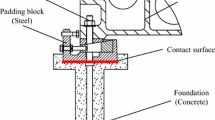Abstract
The machine bed and the concrete foundation are connected by anchor bolts. Foundation creep is a comprehensive manifestation of foundation stability. The size and change of foundation creep affect the dynamic characteristics of the bed-foundation interface and the working state of heavy machine tools. In this paper, the contact problem between bed and foundation made of heterogeneous materials is solved, a concrete crushing hypothesis is proposed, and the basis for determining the elastic–elastoplastic–crushing critical deformation parameters of the concrete surface is formulated. Based on the Hertz contact and fractal theories, an equivalent contact model of the joint is developed, revealing the nonlinear mechanical behavior of the bolted contact surface. The cement hydration and foundation creep factors under continuous loading are taken simultaneously into consideration, and the change trend of the compressive strength and elastic modulus of the concrete at the later stage of loading is determined. By comprehensively analyzing the simulation and experimental results, the error of the theoretical model was found to be within 10%, which verifies the correctness of the proposed theoretical model. Finally, by assuming that the external load remains unchanged, a contact stiffness prediction model based on foundation creep is developed, which can provide a new basis for the contact modeling of bed-concrete foundation joint surfaces.















Similar content being viewed by others
References
Ruiz M, Muttoni A, Gambarova P (2007) Relationship between nonlinear creep and cracking of concrete under uniaxial compression. J Adv Concr Technol 5(3):383–393
Hellmich C, Pichler B, Kollegger J (2015)Mechanics and Physics of Creep, Shrinkage, and Durability of Concrete and Concrete Structures Introduction. Hellmich C, Pichler B, Kollegger J. 3–5 p.
Cai L, Tian Y, Liu Z, Wang Q, Ning Y (2014) Study on dynamic characteristics of heavy machinetool-composite pile foundation-soil. Sens Transducer 179(9):29–35
Greenwood J, Williamson J (1996) Contact of nominally flat surfaces. Proc R Soc Lond 295(1442):300–319
Guo X, Ma B, Zhu Y. (2017) A magnification-based multi-asperity (MBMA) model of rough contact where the Greenwood-Williamson and Persson theories meet.
Wang W, Wu J, Gao Z et al (2018) A calculation model for tangential contact damping of machine joint interfaces. Chin J Theor Appl Mech 50(003):633–642
Hu S, Huang W, Shi X et al (2019) Review on mechanical seals using a bi-gaussian stratified surface theory. J Mech Eng 55(01):103–117
Persson B (2007) Theory of rubber friction and contact mechanics. J Chem Phys 115(8):3840–3861
Zhao Y, Xu J, Cai L et al (2016) Stiffness and damping model of bolted joint based on the modified three-dimensional fractal topography. Proc Inst Mech Eng Part C 231(2):279–293
Yuan Y, Chen J, Zhang L (2018) Loading-unloading contact model between three-dimensional fractal rough surfaces. AIP Adv 8(7):115–124
Liang A, Bian, Y, Chen, Q, Liu, G. (2019) Fractal prediction model for the contact of friction surface and simulation analysis. 2019 8th International Conference on Industrial Technology and Management (ICITM).
Liu Z, Jiang K, Zhang C, Zhao Y, Tian Y (2020) A stiffness model of a joint surface with inclination based on fractal theory. Precis Eng 62:47–61
Zhao Y, Yang C, Cai L et al (2016) Surface contact stress-based nonlinear virtual material method for dynamic analysis of bolted joint of machine tool. Precis Eng 43:230–240
Liao J, Zhang J, Feng P et al (2016) Interface contact pressure-based virtual gradient material model for the dynamic analysis of the bolted joint in machine tools. J Mech Sci Technol 30(10):4511–4521
Zhao Y, Lv Y, Jiang J et al (2007) New elastic-plastic model for the contact of rough surfaces. Chin J Mech Eng 03:95–101
Zhang J, Han YD, Han JG, Wang ZB (2014) Cement hydration based model to predict the mechanical properties of precast concrete. Mag Concr Res 66(12):603–617
Nematzadeh M, Salari A, Ghadami J, Naghipour M (2016) Stress-strain behavior of freshly compressed concrete under axial compression with a practical equation. Constr Build Mater 115:402–423
Zhao Y, Wang H, Liu Z, et al. (2017) A fractal load model of concrete-steel joint interface. 2017 2nd International Conference on Materials Science, Machinery and Energy Engineering (MSMEE 2017).
Yuan Y, Chen J, Zhang L (2018) Loading-unloading contact model between three-dimensional fractal rough surfaces. AIP Adv 8(7):075017
Zhao Y, Xu J, Cai L et al (2016) Contact stiffness determination of high-speed double- locking toolholder-spindle joint based on a macro- micro scale hybrid method. Int J Precis Eng Manuf 17(6):741–753
Tian H, Li B, Liu H et al (2011) A new method of virtual material hypothesis-based dynamic modeling on fixed joint interface in machine tools. Int J Mach Tools Manuf 51(3):239–249
Betonbau. (2013) Fib Model Code for Concrete Structures. Ernst & Sohn
Acknowledgements
The author(s) disclosed receipt of the following financial support for the research, authorship, and/or publication of this article: This work was supported by the National Natural Science Foundation of China (52075012) and the Beijing Science and technology project (Z201100006720008)
Funding
The author(s) disclosed receipt of the following financial support for the research, authorship, and/or publication of this article: This work was supported by the National Natural Science Foundation of China (52075012) and the Beijing Science and technology project (Z201100006720008).
Author information
Authors and Affiliations
Contributions
All the authors on this list contributed to this article.
Corresponding author
Ethics declarations
Conflict of interest
The author(s) declared no potential conflict of interest with respect to the research, authorship and/or publication of this article.
Data availability
The authors declare that all date and material support their published claims and comply with field standards.
Additional information
Technical Editor: Monica Carvalho.
Publisher's Note
Springer Nature remains neutral with regard to jurisdictional claims in published maps and institutional affiliations.
Rights and permissions
About this article
Cite this article
Yongsheng, Z., Nana, N., Hongyan, C. et al. Calculation method of the contact stiffness of bed-foundation interfaces considering foundation creep. J Braz. Soc. Mech. Sci. Eng. 43, 427 (2021). https://doi.org/10.1007/s40430-021-03127-w
Received:
Accepted:
Published:
DOI: https://doi.org/10.1007/s40430-021-03127-w




